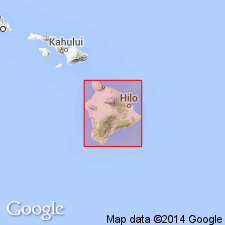
- Usage in publication:
-
- Kahuku volcanic series
- Modifications:
-
- Named
- Dominant lithology:
-
- Basalt
- AAPG geologic province:
-
- Hawaii
Summary:
[Named for Kahuku Pali]. Type locality: in Kahuku Pali [Pali o Kulani, 18 deg 59' 55"N, 155 deg 41' 26"W, Ka Lae 7.5' quad], fault escarpment running north from South Point [Mauna Loa Volcano, Island of Hawaii, HI]. Formerly called Pahala Basalt (Stearns, 1926); name Pahala herein being restricted to top ash member. Comprised of 600 ft of interbedded aa and pahoehoe lava flows overlain by 40 ft of yellow ash at type. Other flows average 15 ft thick. Is exposed intermittently in windows in Kau and Puna volcanic series from Hilo to South Point. Overlies with erosional unconformity Ninole volcanic series; underlies Pahala ash and Kau volcanic series. Assigned probable middle Pleistocene age based on correlation of overlying sand dunes 5.5 mi north of South Point with Waipio low stand of sea.
Source: GNU records (USGS DDS-6; Menlo GNULEX).
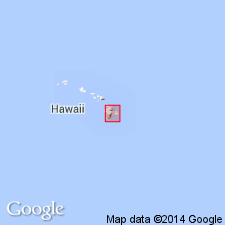
- Usage in publication:
-
- Kahuku volcanic series*
- Modifications:
-
- Overview
- AAPG geologic province:
-
- Hawaii
Summary:
Is dominantly olivine basalt but also includes basalt, picrite basalt of primitive type, and hypersthene-bearing basalt.
Source: GNU records (USGS DDS-6; Menlo GNULEX).
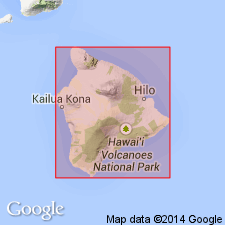
- Usage in publication:
-
- Kahuku volcanic series*
- Modifications:
-
- Paleomagnetics
- AAPG geologic province:
-
- Hawaii
Summary:
"All lavas now exposed on the island [of Hawaii] are less than 1 Ma (Pleistocene)" based on the direction of magnetization being normal [thus Pleistocene]. Samples from 29 different flows at type locality of Kahuku volcanic series were studied.
Source: GNU records (USGS DDS-6; Menlo GNULEX).
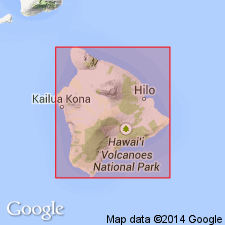
- Usage in publication:
-
- Kahuku Volcanics*
- Modifications:
-
- Revised
- AAPG geologic province:
-
- Hawaii
Summary:
Kahuku Volcanic Series (Stearns and Macdonald, 1946) reduced in rank and named changed to Kahuku Volcanics. Best exposed in sea cliffs and along Kahuku fault scarp. No source vents have been identified for Kahuku flows. Unit is older than Pahala Ash which is as old as 31,000 yr B.P.
Source: GNU records (USGS DDS-6; Menlo GNULEX).
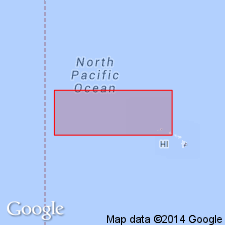
- Usage in publication:
-
- Kahuku Formation
- Modifications:
-
- Revised
- Areal extent
- AAPG geologic province:
-
- Hawaii
Summary:
Name changed from Kahuku Volcanic Series to Kahuku Formation to conform with revision of Code of Stratigraphic Nomenclature (Henderson and others, 1980). Kahuku Formation includes lavas formerly considered remnants of Kulani shield, a shield volcano now partly buried by Mauna Loa (Macdonald and Abbott, 1970).
Source: GNU records (USGS DDS-6; Menlo GNULEX).
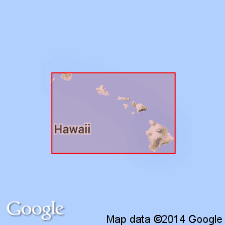
- Usage in publication:
-
- Kahuku Basalt*
- Modifications:
-
- Redescribed
- AAPG geologic province:
-
- Hawaii
Summary:
Name changed from Kahuku Volcanics (Lipman, 1980) to Kahuku Basalt since unit is composed entirely of basalt. "The Kahuku Basalt and the Kau Basalt are approximately coeval with the Hilina Basalt and Puna Basalt respectively, of Kilauea."
Source: GNU records (USGS DDS-6; Menlo GNULEX).
For more information, please contact Nancy Stamm, Geologic Names Committee Secretary.
Asterisk (*) indicates published by U.S. Geological Survey authors.
"No current usage" (†) implies that a name has been abandoned or has fallen into disuse. Former usage and, if known, replacement name given in parentheses ( ).
Slash (/) indicates name conflicts with nomenclatural guidelines (CSN, 1933; ACSN, 1961, 1970; NACSN, 1983, 2005, 2021). May be explained within brackets ([ ]).

